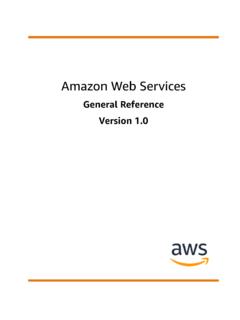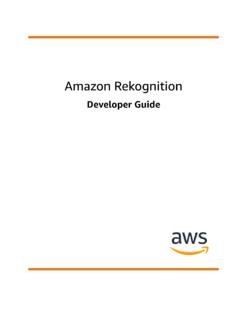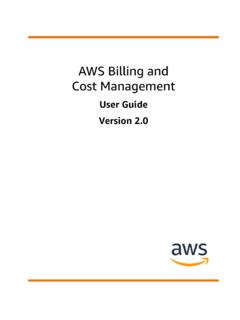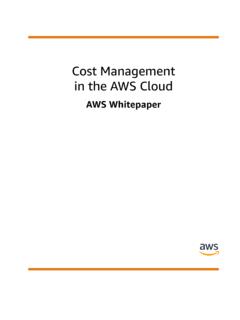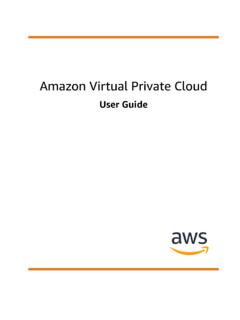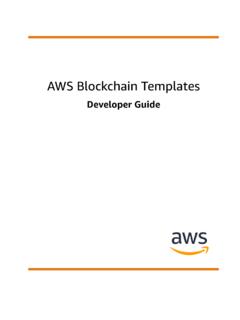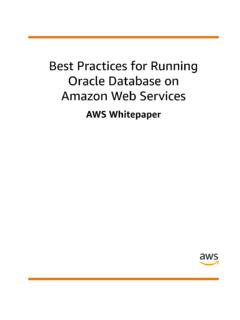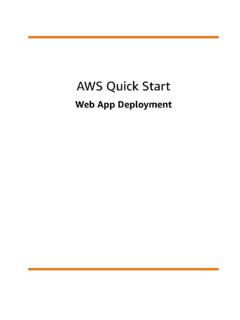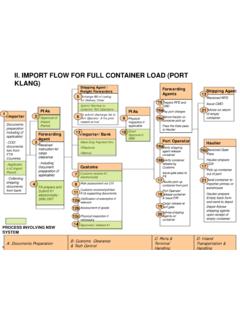Transcription of Elastic Load Balancing - AWS Documentation
1 Elastic load BalancingApplication load BalancersElastic load Balancing Application load BalancersElastic load Balancing : Application load BalancersCopyright 2019 Amazon Web Services, Inc. and/or its affiliates. All rights 's trademarks and trade dress may not be used in connection with any product or service that is not Amazon's, in any mannerthat is likely to cause confusion among customers, or in any manner that disparages or discredits Amazon. All other trademarks notowned by Amazon are the property of their respective owners, who may or may not be affiliated with, connected to, or sponsored load Balancing Application load BalancersTable of ContentsWhat Is an Application load Balancer?
2 1 Application load Balancer Components .. 1 Application load Balancer Overview .. 1 Benefits of Migrating from a Classic load Balancer .. 2 How to Get Started .. 2 Related Services .. 3 Getting Started .. 2 Before You Begin .. 4 Step 1: Select a load Balancer Type .. 4 Step 2: Configure Your load Balancer and Listener .. 5 Step 3: Configure a Security Group for Your load Balancer .. 5 Step 4: Configure Your Target Group .. 5 Step 5: Register Targets with Your Target Group .. 6 Step 6: Create and Test Your load Balancer .. 6 Step 7: Delete Your load Balancer (Optional) .. 6 Tutorials.
3 8 Tutorial: Use Path-Based Routing .. 8 Before You Begin .. 8 Create Your load Balancer .. 8 Tutorial: Use Microservices as Targets .. 10 Before You Begin .. 10 Create Your load Balancer .. 11 Tutorial: Create an Application load Balancer Using the AWS CLI .. 12 Before You Begin .. 12 Create Your load Balancer .. 12 Add an HTTPS Listener .. 13 Add Targets Using Port Overrides .. 14 Add Path-Based Routing .. 14 Delete Your load Balancer .. 15 load Balancers .. 16 Subnets for Your load Balancer .. 16 load Balancer Security Groups .. 16 load Balancer State .. 17 load Balancer Attributes.
4 17IP Address Type .. 17 Deletion Protection .. 18 Connection Idle Timeout .. 18 Application load Balancers and AWS WAF .. 19 Create a load Balancer .. 19 Step 1: Configure a load Balancer and a Listener .. 5 Step 2: Configure Security Settings for an HTTPS Listener .. 20 Step 3: Configure a Security Group .. 21 Step 4: Configure a Target Group .. 5 Step 5: Configure Targets for the Target Group .. 21 Step 6: Create the load Balancer .. 22 Update Availability Zones .. 22 Update Security Groups .. 23 Recommended Rules .. 23 Update the Associated Security Groups .. 24 Update the Address Type.
5 24 Update Tags .. 25 Delete a load Balancer .. 27iiiElastic load Balancing Application load BalancersListener 27 Listener 28 Default 28 Rule Priority .. 28 Rule Actions .. 28 Rule 28 Redirect Actions .. 29 Fixed-Response Actions .. 30 Host 30 Path Conditions .. 31 Create a Listener .. 32 Prerequisites .. 32 Add a Listener .. 32 Configure HTTPS Listeners .. 33 SSL Certificates .. 33 Security Policies .. 34 Update the Security Policy .. 35 Update Listener 36 Prerequisites .. 36 Add a Rule .. 36 Edit a Rule .. 37 Reorder Rules .. 38 Delete a 39 Update Server Certificates.
6 39 Add Certificates .. 40 Replace the Default Certificate .. 40 Remove Certificates .. 41 Authenticate 41 Prepare to Use an OIDC-Compliant IdP .. 41 Prepare to Use Amazon Cognito .. 42 Prepare to Use Amazon CloudFront .. 42 Configure User Authentication .. 42 Authentication Flow .. 44 User Claims Encoding and Signature Verification .. 44 Authentication Logout and Session 46 Delete a 46 Target Groups .. 48 Routing Configuration .. 48 Target Type .. 49 Registered Targets .. 49 Target Group Attributes .. 50 Deregistration Delay .. 50 Slow Start Mode .. 51 Sticky Sessions.
7 52 Create a Target Group .. 53 Configure Health Checks .. 54 Health Check Settings .. 54 Target Health Status .. 55 Health Check Reason Codes .. 56 Check the Health of Your Targets .. 56 Modify the Health Check Settings of a Target Group .. 57 Register Targets .. 57 Target Security Groups .. 58 Register or Deregister Targets .. 58 Lambda Functions as Targets .. 60 Prepare the Lambda Function .. 61 Create a Target Group for the Lambda Function .. 60ivElastic load Balancing Application load BalancersReceive Events From the load Balancer .. 62 Respond to the load Balancer .. 63 Multi-Value Headers.
8 63 Enable Health 65 Deregister the Lambda Function .. 66 Update Tags .. 66 Delete a Target Group .. 67 Monitor Your load Balancers .. 68 CloudWatch Metrics .. 68 Application load Balancer Metrics .. 69 Metric Dimensions for Application load Balancers .. 77 Statistics for Application load Balancer Metrics .. 77 View CloudWatch Metrics for Your load Balancer .. 78 Access Logs .. 79 Access Log Files .. 80 Access Log Entries .. 81 Bucket Permissions .. 86 Enable Access Logging .. 89 Disable Access Logging .. 90 Processing Access Log Files .. 90 Request Tracing .. 90 Syntax .. 91 CloudTrail Logs.
9 92 Elastic load Balancing Information in CloudTrail .. 92 Understanding Elastic load Balancing Log File 93 Troubleshoot Your load Balancers .. 95A registered target is not in service .. 95 Clients cannot connect to an Internet-facing load balancer .. 96 The load balancer sends requests to unhealthy targets .. 96 The load balancer generates an HTTP error .. 96 HTTP 400: Bad Request .. 96 HTTP 401: Unauthorized .. 97 HTTP 403: Forbidden .. 97 HTTP 414: URI Too Long .. 97 HTTP 460 .. 97 HTTP 463 .. 97 HTTP 500: Internal Server Error .. 97 HTTP 502: Bad Gateway .. 97 HTTP 503: Service Unavailable.
10 98 HTTP 504: Gateway Timeout .. 98 HTTP 561: Unauthorized .. 98A target generates an HTTP error .. 99 Document History .. 100vElastic load Balancing Application load BalancersApplication load Balancer ComponentsWhat Is an Application LoadBalancer? Elastic load Balancing supports three types of load balancers: Application load Balancers, NetworkLoad Balancers, and Classic load Balancers. This guide discusses Application load Balancers. For moreinformation about Network load Balancers, see the User Guide for Network load Balancers. For moreinformation about Classic load Balancers, see the User Guide for Classic load load Balancer ComponentsA load balancer serves as the single point of contact for clients.
